|
The Great Western Door and Porch
The porch lies directly
inside the main entrance, flanked by twin doors separated
by a granite column. It has recessed orders with a pointed
arch executed in restrained moulded granite. On the
wall to the right of the main doors are two plaques
- one commemorating the blessing of the Cathedral on
17th December 1989 by Bishop Edward Daly, following
the completion of the re-organisation of the sanctuary
and internal restoration. The second plaque displays
the names of the four Bishops buried at the Cathedral.
Three are buried in the crypt. Bishop Neil Farren (1939-1973)
is buried outside. A new secondary porch, similar in
design to the outer porch was erected in 1989, as was
the small porch in the north aisle. The door on the
right of the ‘secondary porch’ is the entrance
to the spiral staircase which leads to the organ gallery
and the door on the left leads to the belfry.
On passing through
the entrance doors, the visitor is struck by the artistic
beauty of the interior. It is in keeping with the Cathedral’s
outward imposing and beautiful appearance.
The plan of St.
Eugene’s is a simple one of neo-gothic expression.
A lofty, seven bay nave - 160ft (49m) in length and
35ft (10.5m) wide is flanked on either side by aisles
of equal length. Beyond the great chancel wall are another
two bays and two side alters. At the northeast corner
is a small, two storey sacristy block which was extended
and refurbished in the late 1980s. The sacristy has
Tudor style windows with different stone facing as opposed
to the middle gothic style of the windows elsewhere
in the Cathedral.
Above the nave
arcades is the clerestory with twelve pointed windows,
glazed in clear glass. Between the windows, the pine
ribs of the valuted ceiling reach down in the form of
pilasters, terminating on sculptured heads commemorating
saintly personages of Ireland’s past. Depicted
on the ceiling is the oak leaf and the Cross. These
were painted by the firm of Carlin Decorators, Derry,
during the internal restoration work in 1989.
The pews in the
nave and aisles are made of oak and were manufactured
by Messrs. O’Neill Bros., Derry, in 1989.
The
Organ Gallery.
Entering the main
body of the Cathedral, you will pass under the supports
of the organ gallery which was extended in 1904. The
work was carried out by Messrs. Courtney & Co, Belfast.
The slender columns of the gallery contrast with the
massive octagonal sandstone pillars of the nave arcades.
At the top of each column there is a ring of oak leaves
with a dove nestling among them; these are symbols of
St Columba, Patron Saint of Derry. (Derry derives its
name from the Irish ‘Doire Calgach’ meaning
‘The Oak Grove of Calgach’. Calgach was
a pagan warrior who had his camp on the ‘island
of Derry’ in pre-Christian times). Surrounding
the organ gallery are angels holding musical instruments.
There is also a carved Latin inscription which reads:
‘Laudate eum in tympano et choro, laudate eum
in chordis et organo’ (‘Praise him with
drum and dance. Praise him with strings and pipes’)
Ps. 150.
Looking
up from the body of the
church towards the
rear of the nave,
a high pointed arch rises behind the
organ gallery and beyond it the
magnificent Telford & Telford Organ
which was installed in 1873. Behind
the organ is a large stained glass
Rose Window with a Celtic pattern,
which was installed in 1920. This was
the only window in the Cathedral to
be designed by Clokey & Co. All the
other stained glass windows were
the work of Meyer, Munich. |
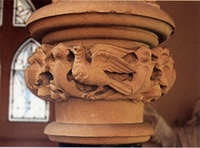 |
North
Aisle.
At the rear of the North Aisle is a large stained glass
window depicting Saint Columba blessing Derry. The window
above the side porch depicts the Agony In The Garden
as as one proceeds up the aisle, the themes of the windows
are as follows:
• The First
Communion of St. Aloysius
• The Raising
of Lazarus
• The Blessed
Virgin giving the Rosary to St. Dominic
• The Triumphal
Entry of Christ into Jerusalem
• Christ
blessing the Children
• Christ
appearing to St. Margaret Mary.
The Stations
of the Cross are located on both aisles. Their meaning
can be clearly and easily interpreted. It is thought
that they were made by itinerant Italian stone masons
who travelled around Ireland carrying out work in many
Irish churches.
Red circles with
a gold cross were painted on the walls for the consecration
of the Cathedral. These crosses were anointed during
the consecration ceremony. Above each circle is a candle
sconce. Candles are traditionally lit each year on the
anniversary of the consecration (21st April) and on
the feast of St Eugene (23rd August).
Baptismal Font
Located
directly at the top of the North Aisle is the
circular baptismal font, made of white Carrara
marble by Stone Developments, Ballinasloe, in
1989. The quotation circumscribing it reads: ‘Springs
of water, Bless the Lord, Give him Glory and Praise
forever’. The quotation is punctuated by
a carving of a large oak leaf, the symbol of St.
Columba, Patron Saint of Derry. |
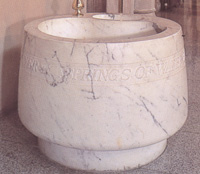 |
The carved wooden
statues on the ledge above the sacristy door were part
of the wooden canopy of the original pulpit erected
in 1906 and removed during the restoration work in 1989.
It was designed by E.J. Toye and carved in Austrian
oak by the firm Ferdinand Stuflesser & Co., Austria.
Blessed
Sacrament Alter
As part of the permanent re-organisation of the sanctuary
in 1989, a new side altar of Sardinian granite was installed.
The altar is used by visiting priests saying Mass or
when there is a small congregation present.
The original
reredos (panelling at the back of the altar) has been
retained. Made of Caen stone and Irish marble, the reredos
is sculptured in huge relief and depicts the Twenty-four
Elders with crowns upon their heads, holding harps and
adoring the figure of the Lamb. The two groups stand
under arched and recessed canopies.
There is a canopied
niche at both sides of the reredos. Saint Peter the
Prince of the Apostles is on the left hand side holding
the keys of the Kingdom (a symbol of the Papacy) and
a book. Saint Paul is on the right hand side holding
a sword and a book. In the wall at the side of the altar
is an ornately carved sacrarium. This was the place
where the water, used to wash the altar linen was poured.
The stained glass window at the back of the altar depicts
the Last Supper.
Main
Altar
In the major renovation undertaken in 1989 a new square
altar of Carrara marble was placed under the chancel
arch. The floor of the sanctuary was extended and completed
in polished Sardinian granite. The ambo, tabernacle
stand and celebrant’s chair were constructed from
Carrara and Macedonian marble. The design of the celebrant’s
chair was kept simple so as not to distract attention
from the Bishop’s chair which is placed behing
it.
The stone and
marble were supplied and fashioned by Stone Developments,
Ballinasloe, and Feely & Sons, Boyle, Co. Roscommon.
The symbolic
oak leaf appears on the edge of the carpet on the sanctuary
floor. The carpet was manufactured and laid in 1989
by Craigie Ltd., Ayrshire, Scotland.
Sanctuary
Lamp
The large ornate brass sanctuary lamp which is suspended
from the ceiling above the main altar was installed
in the Cathedral in 1906. It was designed by a Dublin
architect, Thomas Coleman and manufactured by the Dublin
firm, Gunning & Reynolds. The top of the lamp is
in the shape of a crown and studded with red and blue
glass. The lamp was originally estimated at £50
but was in fact obtained for the princely sum of £25.
The brass on the lamp was refurbished in 1989 by Charles
Beggin, Roscommon.
Tabernacle
The
tabernacle in silver-plated bronze was made and
decorated in 1989 by a Kilkenny silversmith, Peter
Donovan. The symbols on the door depict the Lamb
of God, sheaves of wheat and bunches of grapes
representing bread and wine. Figures of the Twelve
Apostles appear on the sides of the tabernacle,
six on each side. |
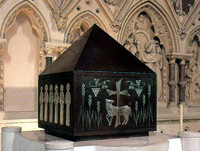 |
The Reredos
The reredos behind the tabernacle was completed in 1904
and is made of Caen stone and Irish marble. The figures
and scenes depicted above the string course in the upper
part of the reredos are, from left to right:
• St. Eugene - Patron Saint of the Diocese
• Group of Adoring Angels
• The Nativity
• Group of Adoring Angels
• Group of Adoring Angels
• The Presentation in the Temple
• Group of Adoring Angels
• Saint Columba in monastic habit with a crown
at his feet.
The scenes depicted in the
lower part of the reredos are, from left to right:
• The Cottage of Nazareth
• The finding of Our Blessed Lord in the Temple
in the midst of the Doctors
• The Healing of the Paralytic
• The Raising of Lazarus.
Bishop Kelly
Memorial Window
When the Cathedral was opened in 1873 all the windows
were of plain glass. In 1891, the glass in the Bishop
Kelly Memorial Window above the reredos and the two
windows over the side altars was replaced with stained
glass. The Memorial Window is divided into seven lights
of stained glass which illustrate significant scenes
from Christ’s life:
• The Nativity
• The Baptism of Christ
• The Agony in the Garden
• The Crucifixion
• Taking down from the Cross
• The Resurrection - Empty Tomb
• The Ascension
Below these are
prominent Saints of the Irish Church - from left to
right:
St. Patrick, St. Brigid, St. Canice, St. Eugene, St.
Columba, St. Dympna, St. Mura.
Bishop’s Chair
|
On the
right hand side of the main alter (close to the
position occupied in 1873) is the Bishop’s
chair. The cross and the episcopal symbols of
a mitre and a crosier are emblazoned in gold on
the leather covering on the back of the chair.
It was carved in oak by Meyer, Munich and installed
in 1898.
The chair
is significant because a Cathedral, as the principal
church of a diocese, gets its name from the Bishop’s
chair - The Cathedra.
|
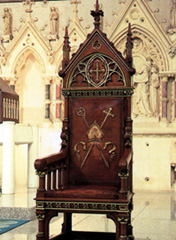 |
Our
Lady’s Altar
This small altar terminates the south aisle and has
been retained in the Cathedral as a shrine to Our Lady.
The statue of Our Lady was purchased from Meyer, Munich
in 1898 and cost £30. It stands on a pedestal
of five clustered columns with carved capitals. At the
back of the statue is an arch of angels, the two upper
angels holding a celestial crown over the head of the
Blessed Virgin.
At each end of
the reredos, made of Caen stone, is a canopied niche,
richly carved and supported by Irish marble columns.
The niche on the left contains a figure of St. Joachim
(the father of Our Lady) holding in his right hand a
staff and in his left, a basket containing two turtle
doves. In the right hand niche is a figure of St. Anne
(Our Lady’s mother) holding a book which is turned
towards the onlooker. The book is inscribed in Latin:
‘ecce virgo concipiet et pariet filium’
(‘behold a virgin will conceive and bear a son’)
Is. 7:14.
Underneath the
altar is the crypt, the final resting place of Bishops
Kelly, McHugh and O’Kane.
| The window at the back of the altar depicts the Visit of the Magi. On the wall to the side of the altar is a bust of Bishop Francis Kelly. The windows inside the chancel depict St. Joseph on his death bed with Mary caring for him while Jesus blesses his foster father, and St. Aloysius Gonzaga being blessed by Pope Pius V in the presence of Cardinal Bellarmine. |
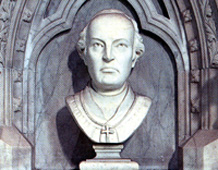 |
South
Aisle
Directly in front of Our Lady’s Altar at the top
of the South Aisle there is accommodation for the choir.
The windows above the choir depict St. Joseph, the Immaculate
Heart of Mary and St. Anthony of Padua, and the Transfiguration.
As you continue
down the South Aisle, the themes of the stained glass
windows are as follows:
• The Presentation in the Temple
• Christ among the Doctors
• The Holy Family
• Sistine Madonna
The stained glass
window at the back of the church, facing the south aisle,
depicts St. Patrick baptising King Eoghan at Aileach.
Top
Left Image : The
tabernacle in silver-plated bronze
Top Right Image : Our Lady's Altar
|